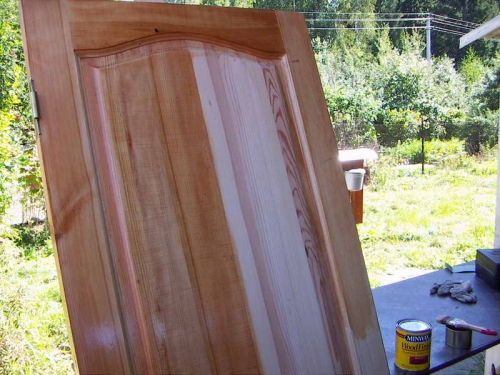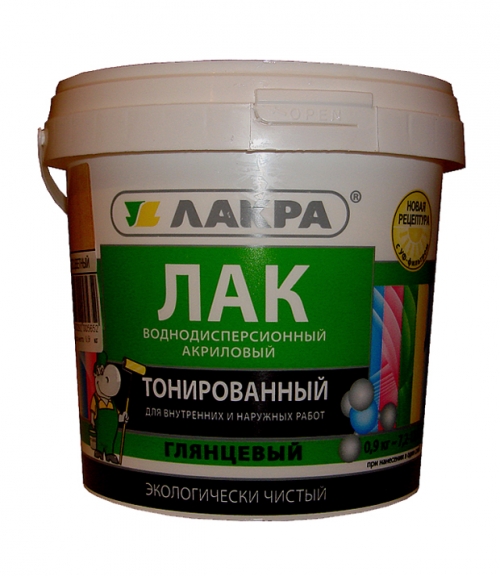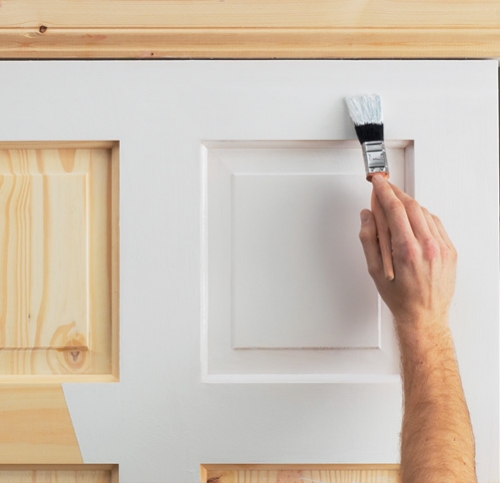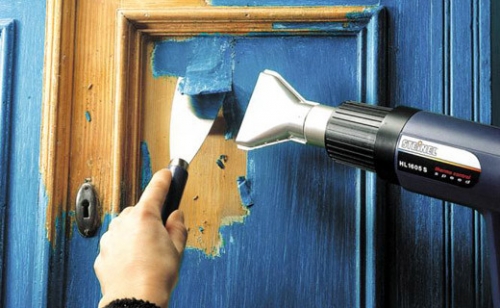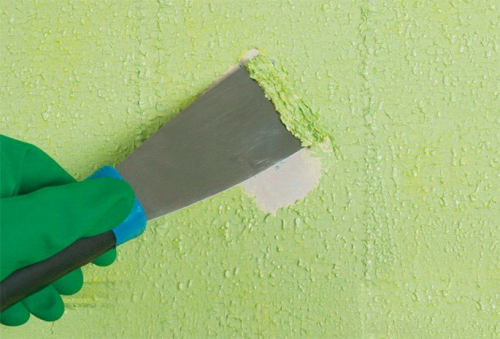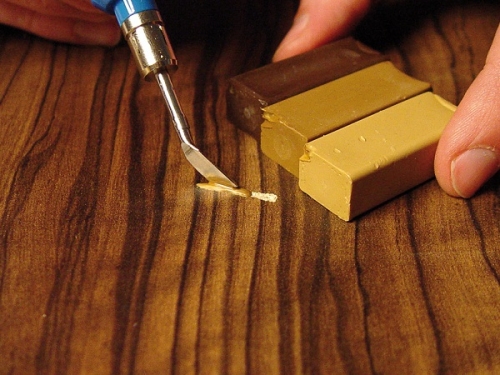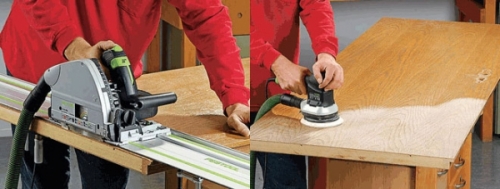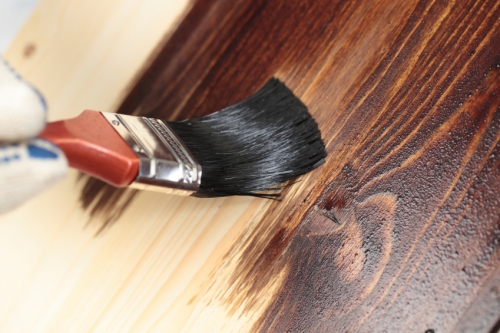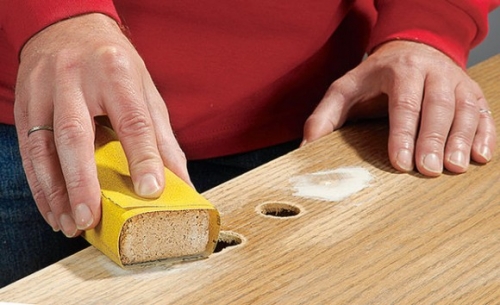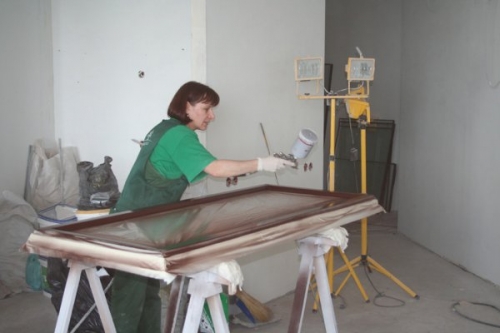The car is not a luxury, but a means of transportation ...
|
|
The plastic window consists of several parts, and each of them should be taken care of ... |
Modern industry offers a membrane to cover the PVC roof, which has ... |
How to paint the doors correctly

For a decorative and protective coating of a wooden door on sale, there is a large range of paintwork. The article will talk about which paint to paint the doors in different operating conditions.
Content:
- Which paint is better to paint wooden doors
- How to paint the doors correctly
- Painting with a stain
- How to paint laminated doors
Which paint is better to paint wooden doors
Varnishes
This is a traditional coating for wood. It gives shine, retains the color of the material and protects it. The varnish, as a rule, is chosen to cover doors in baths or saunas. It is most convenient for them to cover new products, since the old ones will require careful preparation, which turns on the grinding of the entire canvas to an original light color. True, you can choose immediately tinted varnish, which will give color and lay it in one trick.
Lucky, although it seems universal at first glance, have various compositions and destinations.
- Nitro -cellulose varnish Suitable for covering wooden doors in residential premises. It is not recommended to use it in baths or bathrooms due to the low strength of the resulting coating. It can crack quickly.
- Acrylic lacquer.Resistant to ultraviolet rays and adverse effects. It is glossy or matte, most often does not have an unpleasant odor. The door processed by him can be washed.
- Polyurethane varnish. It has high adhesion with a wooden door surface and high strength characteristics. There are glossy, semi -gloss and matte. They are suitable for applying not only to wood, but also on veneer, parquet, countertop. It is resistant to abrasion, but give yellowness to light wood.
- Water -based varnish. It dries for a long time and has no unpleasant odor. Their properties can vary greatly, as manufacturers include different additives. More accurate information can only be found on a bank with a composition.
- Polyester varnish. They are toxic and with a pungent odor, which is why they are chosen for painting wooden doors on the street. Create a particularly strong coating.
Tip: if the door of street construction is painted, then it is important where the work is done and which composition. If it is located in the sun, then it is worth choosing long -term compounds, which, when heated, penetrate better into the structure of the tree and are more evenly applied. If the varnish is quick -drying, then it will evaporate too quickly, which will lead to uneven painting. It is even better if the door is previously removed from the loops and will be painted indoors. This will help to avoid sticking dust and insects.

- Oil varnishes. They are distinguished by a large content of fatty resins, so they are incompatible with some paints and varnishes. Therefore, before application, it is necessary to completely clean the wooden door from the old coating. The consistency is quite thick, therefore it is more evenly to lie down with a brush than a spray gun. They have no pungent odor. Wax oil varnishes are able to lighten soft wood.
Now about how to paint wooden doors: for interior, the best choice will be a polyurethane or acrylic -based varnish. But for external work or for bath doors, it is best to choose persistent varnishes, the so -called deck.
Stains
Their task is to tint wood and short -term protection against adverse factors. But such a coating is required to be constantly updated. They do not hide their main advantage, but rather emphasize the beautiful structure of the tree.
4 types of stains are produced:
- based on alcohol, it dries most quickly, but has a pungent odor and a higher price;
- on water -based, it will take more time to dry, but has no unpleasant odor. Suitable only for internal work in rooms with normal humidity;
- based on the oils before use, they need to be diluted with solvents, for example, acetone;
- on a lacquer basis, they are most often called azure. Despite the fact that they significantly reduce painting work, it is quite difficult to achieve a beautiful result. To obtain a flat, plain surface, it should be sprayed with a spray gun.
Tip: Choosing between a quick -drying stain and slowly drying, it is necessary to take into account not only the time of their drying, but also the result. So, water -based compounds penetrate deeper into wood, making the color more saturated, and the pattern is clearer. If the pattern is not important, but you need a quick result or light color, then alcohol stains are recommended to choose.
Paints
With the help of colors, you can not only paint new doors, but also restore old canvases. The main thing is to understand the types of paint and choose the right one.
- Paints related to opaque coatings are made on the basis of organic solvents, such as polyurethane, acrylic, etc. This group also includes water-dispersion acrylic coatings. Despite their toxicity and fire hazard, they are very popular due to the simplicity of application and high quality of the resulting coating.
- When choosing which paint to paint interior doors, most often they stop their choice on alkyd paints with water -repellent properties. They lie superficially, without penetrating the structure of wood, and form a dense strong film up to 1 mm thick. When working, it is important to observe one nuance: applying is possible only on a completely dry surface, otherwise air bubbles are formed, which will lead to the efficient cracking of paint.
- To date, olifa -based oils have practically disappeared from the sale. This is due to the high price and low strength characteristics of the protective layer. Sometimes it is replaced by an alkyd resin of Oksoli, this reduces the cost, but the composition acquires a sharp unpleasant odor, which lasts steadfastly for several days.
- The most popular are acrylic and polyurethane paints based on organic solvents. This is especially true for water-dispersion compositions, water was used as a solvent (this is a classic version of the white painted doors of Canadians). They have no smell and create a vapor -permeable coating. When they dry out, a film is formed that protects the wooden door from humidity and temperature difference. But when freezing in the bank, they lose their properties.
- The colors are universal, they can be painted both prepared wood and directly on the old coating.
How to paint the doors correctly
Before painting wooden doors, a number of preparatory work must be carried out.
Surface preparation
Most often, this applies not to new doors that require restoration or simply update. Preparatory work, first of all, involves the removal of the old paintwork. This is done either with a skin or a spatula. But both of these options will take a lot of time. Consider how to simplify the task.
- Warm the surface with a construction hairdryer. This household instrument is often in demand and is inexpensive, so almost every home master has. Unlike domestic, it has a significantly greater power and heats it stronger. It is enough for a few minutes to bring it to the old paint, as it starts to bubble. After that, cleaning it with a spatula is much easier and faster. You need to work in gloves. Inexpensive hair dryers quickly overheat, so you can’t work for a long time.
Tip: When cleaning a wooden door using a construction hairdryer, it is impossible to set a temperature above 220oc, otherwise the structure of wood is severely damaged and will continue to collapse faster.
- Washing off paint. This is the name of special chemical compositions designed to remove paint. In appearance, this is a gel -like mass of a transparent color or with a slight shade. There are several types on their sale, in this case it is necessary to choose a wash, on the label of which it is indicated that it is intended for wood. It’s easy to work with it, it is enough to evenly distribute it with a brush over the entire surface of the door and leave it for 30 minutes (the paint should begin to retreat). Next, it is cleaned with a spatula or scraper. When preparing the surface of the door in this way, it is impossible to immediately proceed to the subsequent coloring. At first, everything is carefully wiped with a dry rag, then it is washed with a soap solution and allowed to dry.
Tip: all flushing compositions for paint have a pungent smell, from which dizziness can begin. Therefore, it is recommended to take security measures. If after applying the gel to immediately cover the surface with a film (ordinary food) is suitable, then the smell will be slightly smaller, and the effect of the composition is better.
- The folk method. It has been tested for years, this will require acetone, film and spray gun. Using sprayers on the surface of the wooden door, acetone is sprayed and immediately, preferably in several layers, a film is superimposed. It is important that it adjacent tightly, without air access. As a result, after 15 minutes, the paint will begin to bubble and retreat. But the composition of acetone negatively affects wood.
How to make cracks and chips
- Wood is quite vulnerable. Therefore, during the operation of a wooden door, chips, dents or cracks are often formed on it. During restoration, they can be closed so that after painting they will become invisible.
- For masking minor defects, wood putty is useful, for large - furniture wax. Outwardly, they are easy to distinguish, the latter looks in the form of a dense bar, and putty, like all analogues, pasty consistency. All types of repair compositions for wood have a palette of shades that are closest to natural. You need to choose the most close to the color of the door of the door.
- Before restoration of the door, it, cleaned of paint, is wiped with a rag dipped in the solvent. Then, a little putty is taken with a small spatula and the gap is tightly filled. The surface is immediately smoothed so that there are no grooves. It is convenient to work with a rubber spatula, which is applied to the grout when laying tiles.
- Lining a large flaw, a slightly furniture wax is heated with a white fringe with a thick sting. A softened, but not liquid mixture is applied to the repaired area. If the curly part breaks, then you need to try to repeat its contour with mass. If the gap is sealed on a flat surface, then the patch should perform somewhat. This is necessary in order to then align with sandpaper and smooth it.
- When working with wax or puttying, although it turns out to be a tone to disguise the chip, but still it will stand out due to the lack of a drawing of wood texture. But there is a way out here. There are special furniture markers on sale, which are also selected in color. With their help, dashes are applied, repeating the picture of the base. It costs cheaply, within 50 - 100 rubles. They paint them at the last stage before applying varnish or stain.
Grinding the door
- Often you need to grind even a new wooden door. If it has even small chips, bullying or unevenness, this procedure should not be missed. This is done either with a grinding machine or manually with a skin.
- For ease of work, you can manually fasten a piece of skins on screws to a small bar or fix with nails. The main thing is that the hats are drowned and could not scratch the surface. First, processing is carried out with coarse -grained paper, and only then fine -grained. It is recommended to pay special attention to the ends with transverse cuts, which, as a rule, always have roughness.
- Grinders significantly accelerate the workflow. For primary rough processing, a circular grinding machine is required, and for the finish belt. If the door has patterns or relief, then you can’t do without a manual skin.
Application of the primer
A roller with a small pile, a brush, sponge or spray gun may come in handy for applying the soil. It is important that the brushes or rollers do not leave villi or hairs. It’s enough just to rub them with your hand before starting work.
As rules, primers are colorless and have a very liquid consistency, so applying them will not be difficult. But there are recommendations on this subject:
- impregnations and stains on a wooden door is more convenient to apply a swab from a natural sponge;
- water -based soils and alkyd are applied with brushes, diligently rubbing so that it does not form subtexts. The movements of the brush should be ordered from top to bottom or vice versa.
After drying the primer, the surface is checked with the hand. Sometimes the composition lifts the villi, making the woods with a rough to the touch. It is required to once again slightly walk with a finish skin with the smallest grain.
Applying finish
- If there was no special primer at hand, it can be made independently from the paint, which is designed for the door. To do this, it is diluted with a solvent in a ratio of 1: 2. It is more convenient to apply it with a brush. In the future, this contributes to a more even color and lack of non -color.
- Before use, the paint is well mixed. At a time, it will not be possible to evenly paint the entire area of \u200b\u200bthe door. And do not try to do this, applying too thick a layer of paint. If some place remains lighter, it will close the subsequent layers.
- If the door was not removed before painting, and it is in an upright position, then work begins on top, gradually going down. This will avoid a drop of drops on a previously painted surface. With a horizontal location of the canvas, you can paint as you like, but adhering to a given direction, without chaotic strokes and docking points.
- The first layer is left until completely dry. Time is individual, depends not only on the composition, but also on the temperature and humidity of the environment. As a rule, this takes no more than a day for alkyd colors.
Tip: When buying LKM in a store, the buyer tries to choose a composition that dries as quickly as possible. The best indicators in this regard in water -based paints. But they differ in low moisture resistance, so for painting a wooden door in the bathhouse are not recommended.
- When drying, the surface is carefully examined. Almost always, the paint lifts the wood fibers, which were smeared during stressing. You can’t leave them, you will have to walk again with a skin. It's okay if the wood begins to shine slightly somewhere, but all this should be avoided.
- The second layer is recommended to apply across the door leaf. As in the first case, you can not make a too thick layer of paint. After drying, there should already be an absolutely smooth surface. Often, two layers are enough, but if there are doubts about the homogeneity of the coating, then the last third layer is applied.
Painting with a stain
Painting a wooden door with stains differs from painting LKM.
- Stains, regardless of the basis on which they are produced, have a fairly liquid consistency. In order for the color to lie down evenly, before painting, the wood is moistened with water, which contributes to a smaller absorption of the composition and a more uniform distribution.
- If the door is located vertically, you need to apply a stain from the bottom up so that its drops do not fall on the still unpainted surface. This also applies to a door frame with slopes.
- When painting in a horizontal plane, the first layer is applied along the wood fibers. After drying, the second time the composition lies across, and the third finish is again along. Thanks to this, uniform tinting of all elements and from all sides achieves uniform tinting. It should be noted that after drying the color will be somewhat lighter than when applying. Therefore, to achieve the desired result, more layers are sometimes required.
- Like the paint, the stain lifts the fibers, forming a rough surface, which must again be polished by zero.
- When using an alcohol -based stain, you will not have to be grinded again, since it does not raise the fibers. In addition, the drying time is only half an hour. But still, the first place in popularity is occupied by aqueous solutions, due to their environmental friendliness and non -toxicity.
How to paint laminated doors
Laminated coating, especially in interior doors, displaces products from natural wood. They look beautiful, can imitate expensive wood species, are easy to operate and compared to doors from an array, are affordable. It is no wonder that it is they who occupy the honorable first place among the doors installed in apartments and country houses. Despite the durability of the material, they are also subjected to mechanical damage. But many owners do not know whether it is possible to paint laminated doors and throw out new ones. Next, consider how to restore it with painting.
If it was required to mask spots or scratches, then you will have to choose opaque colors. Also for work you will need:
- brush or roller;
- spatula and putty for wood;
- rags;
- sandpaper;
- solvent;
- enamel for laminated surfaces.
Stages of work
- Lamination on the door has low adhesion with all materials. If you just start applying it, it will slide it, forming smudges and spots.
- Therefore, the entire surface must be thoroughly sanded and brush off with a dry rag all the dust that has formed.
- The entire door is covered with a thin layer of putty. The thinner and more uniformly the layer, the better it grabs with the surface, creating a strong coating. When it dries, it is slightly polished with a skin-linen, focusing on possible irregularities. Then the second layer is applied and is also aligned with grinding after drying. In addition, this will make the surface more rough, which guarantees the best clutch with finish paint.
- For painting a laminated door, it is better to prepare a more liquid composition of the paint, for which it is diluted with a solvent by half. (It is recommended to choose the composition of the White Spirite).
- In the absence of a spray gun, it is best to perform work with a brush. It is thoroughly applied to paint, rubbing it into all inaccessible places. It is important to ensure that the influxes do not form. It is better not to paint them than to apply excess. If this could not be avoided, then after drying it is cleaned with a skin.
- To consolidate the result, after three layers of paint, varnish is applied.
In the case when the laminated door has no defects, but you just want to update it, you can use a stain or tinted varnish (the latter can only be applied with a spray gun). The technology will only be polished, tinted and further coated with varnish. Therefore, if there are doubts about whether it is possible to paint the venerable doors or from any other materials, then, subject to the above technology, it is permissible to do this.
Is it possible to paint the doors of MDF video

